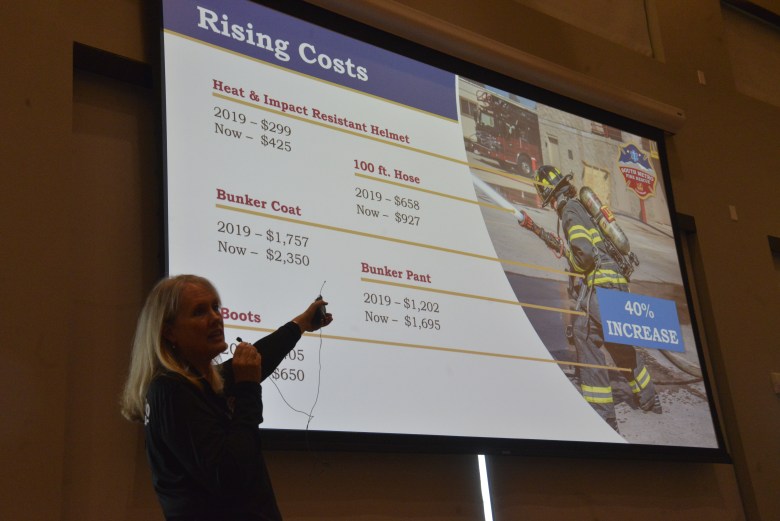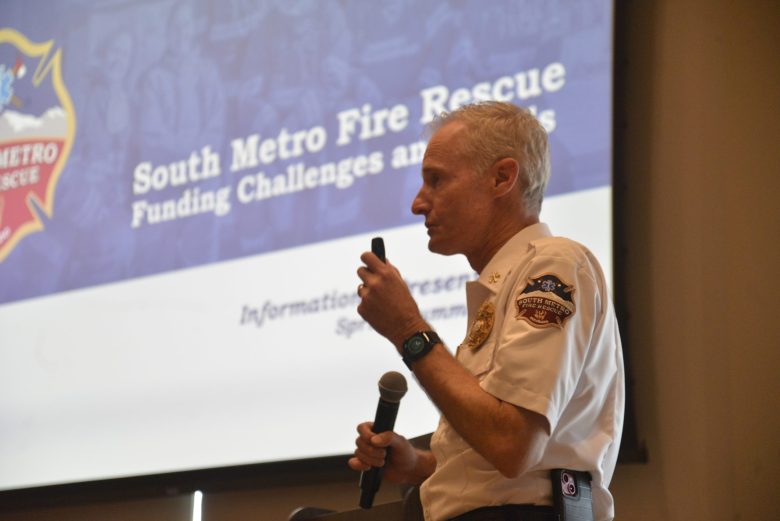South Metro Fire Rescue has stated that it is facing a budget shortfall in 2026, so the board of directors is seeking the public’s input on whether to cut services – or, if the agency were to put a tax increase question on the November ballot, what would it look like.
Mike Dell’Orfano, the chief government affairs officer with South Metro Fire Rescue, said that due to a combination of costs and legislation, there will be a $16 million shortfall by 2026 and nearly $270 million over the next decade.
“It’s kind of a story of increasing demand, increasing costs and decreasing revenue,” said Dell’Orfano.
On top of the shortfall, South Metro Fire Rescue is needing an additional $34 million annually to maintain its level of service to communities and retain staff.
Renee Anderson, vice chair of the South Metro Fire Rescue Board, said that the board’s goal is to maintain the agency’s efficient response time and adequate staffing, but without additional revenue, it will not be able to maintain the high-quality fire and emergency services it strives to provide.
However, according to community survey results from January and February, which reached more than 2,000 registered voters in the fire district’s service area, about 41% believe that South Metro Fire Rescue has the financial resources to provide an acceptable level of fire protection, ambulance and emergency services in their given community. About 34% were unsure and 25% did not believe the district has the financial resources it needs.
Where is the need coming from?
South Metro Fire Rescue is a full-service fire and emergency medical provider with 30 stations located across parts of Arapahoe, Douglas and Jefferson counties, which includes 12 municipalities that are home to some major businesses such as Lockheed Martin and the Centennial Airport, serving more than 571,000 people.
Over the past six years, Dell’Orfano said there has been about a 25% increase in the agency’s call volume, with EMS being the most-needed service.
“As we increase demand, that puts more demand on stations,” said Dell’Orfano. He added that the agency may “need to consider different crews or types of services to handle the changing needs of the community.”
More than half of the above-mentioned survey participants agreed that the need for medical services has increased in the last five years.
Anderson added that the agency – across the various municipalities – is an entire system that responds when something is happening within its boundaries.
“As the population grows to the south, we will be pulling resources from Centennial, Cherry Hills and the Aurora area,” Anderson said.
The agency has also been experiencing a 40% to 79% increase in costs for gear and apparatuses.

Additionally, every firefighter requires two sets of bunker gear, which includes a helmet, jacket, protective pants, a pair of boots and gloves. They are required to have two sets due to the different types of carcinogens that get on the gear while responding to calls. And, they must be replaced every five years.
According to the agency, the cost to purchase a new fire engine increased from about $725,000 in 2019 to $1.3 million today, and a 100-foot hose increased from about $660 to about $930.
Within the past six years, one set of bunker gear has increased in price from about $3,660 to $5,120, according to South Metro Fire Rescue.
“That’s a 40% increase just to keep our firemen and women safe and able to do their job,” Anderson said.
Anderson said another reason for the shortfall was partially due to House Bill 24B-1001.
Anderson said while the bill aimed to reduce property taxes statewide, it unintentionally slashed funding for fire districts. She added that even if this legislation didn’t pass, South Metro Fire Rescue would still be reaching out to the community concerning revenue problems, just in a few years.
What South Metro entails
South Metro Fire Rescue is more than just a fire department, the agency includes multiple special operations.
There are five response teams, which are aircraft rescue and firefighting, water rescue, hazardous materials, technical rescue, and wildland firefighting and mitigation.
There are also four deployment teams and three operational support teams, which are extrication, research and development, and self-contained breathing apparatus.
In terms of emergency medical services, the agency has nearly 30 advanced life support paramedic vehicles and 19 basic life support vehicles.
As part of its community risk reduction efforts, South Metro Fire Rescue also offers education programs. Its Public Health Program, which provides in-home care, medical resource connection and supports long-term health solutions for people, reached more than 1,200 patients in 2024.
Potential solutions to the budget shortfall
According to South Metro Fire Rescue, one solution for its budget shortfall would be to cut essential services.
If services were cut, a smaller firefighting crew could potentially compromise safety during emergencies and impact patient care. The cuts could also reduce wildfire response and that of other specialty units.
The second option is to increase property taxes by raising the mill levy from 9.25 – which has been in place since 2004 – to 12.25.
“South Metro has the lowest mill levy tax rate of any sort of similar career fire protection district that offers all services throughout the front range,” Dell’Orfano said.
A mill is $1 for every $1,000 of an assessed value. This potential rise would cost the average homeowner with a $750,000 home about $11.72 more per month. Homeowners can learn what the increase would look like for them with South Metro’s property tax calculator found at tinyurl.com/property-tax-calculator.
If voters chose this option, it would generate about $50 million each year for South Metro Fire Rescue, according to the agency’s website.
The third option would be to collect a new 0.5% sales tax. This would be $0.50 for every $100 spent, generating about $50 million per year.
According to the community survey from the beginning of the year, 68% of participants said they would support a modest tax increase to create additional funding being placed on the November ballot.
If they had to choose between the two tax increase options, 49% chose a sales tax, 15% chose property tax, 18% chose neither and 18% were unsure.
An alternative ballot measure option would have voters approve or reject a 1.6 mill levy property tax increase specifically dedicated to the agency’s capital needs. Survey results regarding this question showed that about 51% said they would reject it, 25% were unsure and 24% said they would approve it.
Despite what measure voters decide on and if it passes, Anderson said the funds will only go to South Metro Fire Rescue.
“It’s South Metro’s question, it’s South Metro’s revenue,” Anderson said.
Community members can provide feedback at engagesouthmetro.org/funding-solutions.


